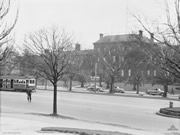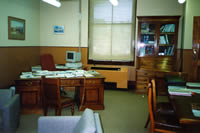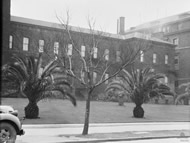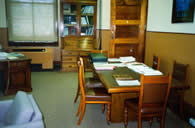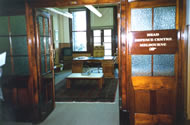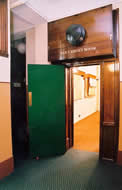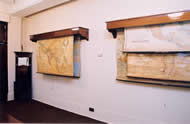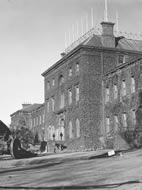The earliest buildings at Victoria Barracks were built by soldiers in the late 1850s, with the original bluestone buildings being constructed between 1856 and 1872. A large extension was made to officers’ quarters in 1917 but with the growth of service personnel and civilian staff at the beginning of the Second World War, space was at a premium.
Victoria Barracks was the administrative headquarters for the Australian Army but to ensure the close coordination of the three services necessary to the war effort, the Barracks also became the administrative headquarters of the Royal Australian Navy and Royal Australian Air Force.
As well, accommodation needed to be found at the Barracks for Ministers and staff travelling to meetings of the War Cabinet and the Advisory War Council in Melbourne.
Victoria Barracks, 1943. View of main building looking
across St. Kilda Road.
Australian War Memorial: ID 052350
Consideration was even given to utilising nearby parks as temporary homes for the overflow, and this led to the unsuccessful 'Fawkner Park grab' which prompted an anonymous poet from the Defence Department to put pen to paper:
| The trumpet sounds the call to war, And all within its hearing hark Well – not quite all. We must except The sportsmen bold of Fawkner Park |
The foemen strikes old England hard, We stand beside her stern and stark Well some of us. We must except The sportsmen bold of Fawkner Park 1 |
In 1940, a five story red brick extension - 'N Block' - was erected behind the original 'C Block' to house the administrative headquarters of the Navy and the Air Force.
The Defence Secretariat Offices
The Defence Secretariat occupied the second floor of 'A Block New Wing' (completed in 1918) which also contained the office of the Minister for Defence, the Secretary of the Department, visiting Ministers and their various secretaries and staff, and the War Cabinet room. 2
The Secretary of the Department of Defence, Sir Frederick Shedden, occupied a room adjacent to the Prime Minister’s office, which he could access through a small connecting anteroom.
Mrs Guy Smith of Myers Stores supervised the redecoration of the Defence Secretariat Offices in May 1940.
The Prime Minister’s office, which faced St Kilda Road in one corner of the building, was carpeted in green with matching curtains. As there was not enough carpet to complete the private secretary’s office, Mrs Smith left a twelve-inch border of stained boards in that room.
The two offices and the ante room were connected by baize doors, but a glazed door to the vestibule was left to allow more light.
As a concession to economy other offices were fitted with second hand carpet squares. 3
Desk used by Prime Ministers at Victoria
Barracks, as photographed in 1995.
John Curtin Prime Ministerial Library. Records of the John Curtin Prime
Ministerial Library. John Curtin's desk in his office at the Victoria
Barracks, 1995. JCPML00119/18
Right hand wing of Victoria Barracks, facing St. Kilda
Rd., 1943
Australian War Memorial: ID 052352
The Prime Minister's office at Victoria Barracks as photographed
in 1995.
John Curtin Prime Ministerial Library. Records of the John Curtin Prime
Ministerial Library. John Curtin's office at Victoria Barracks, 1995.
JCPML00119/19
Office at Victoria Barracks as photographed in 1995.
John Curtin Prime Ministerial Library. Records of the John Curtin Prime
Ministerial Library. Office at Victoria Barracks, 1995. JCPML00119/20
The most significant room in the Victoria Barracks was the specially fitted out War Cabinet Room at the other end of the corridor from the offices of the War Cabinet Secretariat.
In preparation for its role the room was extended to the south. It was soundproofed by placing a large layer of felt under the carpet in the rooms above, and by fitting soundproof windows above the two access doors, which had already been soundproofed. Fibreboard was attached to the original glazed doors with wooden beading, and sometime in May 1940 these doors were replaced with a system of baize lined double doors, which were still in situ in 1995. 4
The floor was covered with a practical dark brown carpet with matching heavy lined curtains covering the windows, which were fitted with wind baffles. A map board was concealed in the lockable varnished wooden panels on the east wall, and pull down roller maps were located in two canopies on the south wall. The room was lit by five contemporary pendant lights and heated with several small wall radiators.
A large oval polished table stood in the centre of the room. It was surrounded by upholstered chairs, and each chair space was provided with push button communication to minister’s staff, or a messenger. The table was furnished with cigarette boxes and brass ashtrays and hearing equipment was fitted to the table in front of Mr Hughes, who usually sat two seats to the right of the Prime Minister. 5
Shedden’s secretarial assistants sat at a small blackwood table in the northwest corner of the room, where there was a telephone, and accurate time was provided by a clock mounted on a column which was part of the Post Master General’s Masterclock system used throughout the Barracks. 6
An emergency War Cabinet Room was established in the basement of A Block New Wing at the start of the Pacific War. Its external windows were bricked up in case of enemy attack and the ceiling strengthened so the War Cabinet could continue to meet. This room was not used regularly, and in fact may not have been used at all. 7
Provision was made for ministers to dine privately in a special room set aside for them in M Block canteen, and there was a standing order for morning and afternoon tea of seven teas and six biscuits. Cigarettes and Admiral brand cigars were initially purchased from the Cabinet fund, but when the cigars proved too expensive a change was made to the cheaper Cubanola Principes cigar at the suggestion of Prime Minister Menzies. 8
Security at the Barracks
Security at the Barracks was a concern from early 1939. Cleaners were left to lock doors and gates at the end of the day, and a cleaner was left in charge of South Gate until 8.00pm when a Peace Officer took over. 9
Defence personnel were not as security conscious as they should have been and left doors open making it easy for eavesdroppers to listen to discussions on sensitive topics. 10
A specially formed Inter-Service Committee recommended reviews of the protection of secret documents and on strong room and safe facilities. It also recommended that the Barracks be protected from listening devices on the telephone system, and that sensitive areas be secured against unauthorized entry. Plans were also made to prevent incursion by enemy agents. 11
Evacuation procedures were established. If an air raid occurred lift attendants were instructed to take their passengers to the ground floor, then return their lifts to the top floor and immobilize them. The attendants were then to leave the building by the stairway. To deter aircraft an anti-aircraft machine gun was installed on the southern tower of G Block. 12
The head of Air Raid Precautions, Mr Carrodus, established blackout practices in December 1941, however on one occasion the Prime Minister and Defence Secretariat staff were forced to stay late with the lights doused because the blackout curtains proved inadequate. 13
Government ministers and their staff based at the Barracks required security cover, and a secure teleprinter link was established between the Canberra Defence office and the Department's headquarters in Victoria Barracks, Melbourne. Secret telephone facilities were also available.
Corridor and door leading into the War Cabinet room, 2004.
War Cabinet room, 2004
War Cabinet room showing original maps from World War Two, 2004
3 images above: John Curtin Prime Ministerial Library. Records of the John Curtin Prime Ministerial Library. War Cabinet room, Victoria Barracks Melbourne, 2004. JCPML00871/1. Photographer Peter Mappin
The War Cabinet meeting around the large oval table in
the War Cabinet room. Cigarette boxes and ashtrays were provided, 1943.
Australian War Memorial: ID 139923
The solid and imposing building housing Army Headquarters
at Victoria Barracks in Melbourne in 1945 presented a secure exterior
to the world.
National Archives of Australia: A1200, L248

